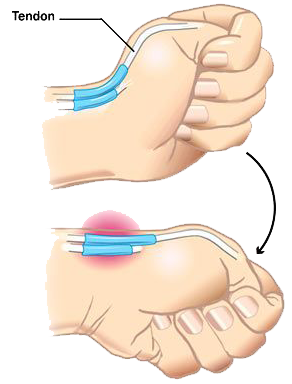De Quervain’s Tenosynovitis by Ebony Roberts (Physiotherapist)
What is it?

De Quervain’s tenosynovitis is a common cause of wrist and thumb pain in adults. It is characterised by pain or tenderness along the radial (thumb side) of the wrist and/or base of thumb. It affects two thumb tendons called abductor pollicis longus and the extensor pollicis brevis. These tendons are responsible for moving the thumb backwards and sideways. In De Quervain’s these tendons become trapped in the small tunnel they pass through which can cause inflammation and irritation consequently causing pain and leading to restricted movement.
Symptoms
Patients typically present with pain along the back of their thumb and/or wrist which may also travel up the forearm. Swelling may be evident at the base of the thumb and/or wrist. Additionally, there may be weakness and/or reduced movement of the thumb and wrist, particularly when trying to pinch, grasp or twist. Symptoms can come on gradually or suddenly with an associated incident.
Risk factors
- De Quervain’s usually affects adults between 30 and 50 years of age.
- Females are 8 to 10 times more likely to be affected by De Quervain’s compared to Men.
- Repeated workplace tasks that require hand or thumb movements such as wringing, grasping, pinching and squeezing.
- Inflammatory conditions like rheumatoid arthritis
- Hobbies like gardening, gaming, racket sports, music, drawing
- Scar tissue from a previous injury in the same area.

Diagnosis
A thorough subjective and physical assessment from a Physiotherapist can determine the likelihood of De Quervain’s. The subjective assessment will include activity levels, work place and lifestyle risk factors, aggravating and easing factors and the location of pain. Whilst the physical assessment will include observation, palpation of structures, range of movement and grip strength. Your physiotherapist will also perform a Finkelstein’s test. This involves creating a fist with the hand, then tilting the hand away from the thumb. A positive result is pain on the thumb side of the wrist. An ultrasound examination may also be performed to help diagnosis De Quervain’s.
Treatment
Non-operative management aims to relieve pain and symptoms and decrease any inflammation present. During the early stages of rehabilitation your Physiotherapist may place you in a thumb spica splint to reduce repetitive loading and irritation on the area and decrease inflammation. Your physiotherapist will also discuss activity modification with you. Your GP may additionally prescribe anti-inflammatory medication to help ease pain and inflammation in the early phases.
Once the pain and inflammation has settled, you will be guided by your physiotherapist through a range-of-motion and strengthening exercise program to gradually return you to work, sport or your normal activities. Physiotherapy treatment may also include massage, ice therapy, strapping, hands on stretching or therapeutic ultrasound.
Surgery is a last resort and only considered for individuals who have had the condition for a prolonged time, is severe in nature and has attempted conservative treatments with no success.
References:
Papa, J. A. (2012). Conservative management of De Quervain’s stenosing tenosynovitis: a case report. The Journal of the Canadian Chiropractic Association. Retrieved from: https://www.ncbi.nlm.nih.gov/pmc/articles/PMC3364060/
Ritu. G., & Abzug. J.M. (2015). de Quervain’s tenosynovitis: a review of the rehabilitative options. American Associtation for Hand Surgery. 10(1). Retrieved from: https://www.ncbi.nlm.nih.gov/pmc/articles/PMC4349843/
Katechia. D., & Gujral. S. (2017). De Quervain’s tenosynovitis. Sage Journals. Doi: 10.1177/1755738017713515
Book an appointment today for your assessment!
Blog by Ebony Roberts (Physiotherapist)

